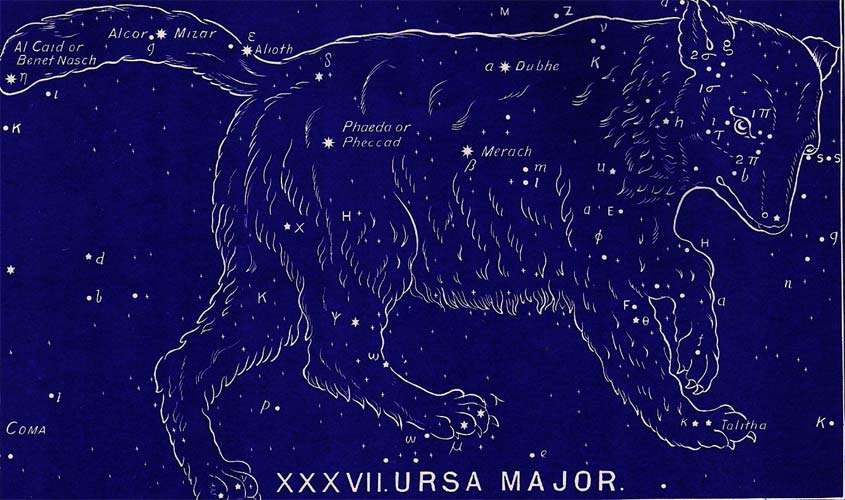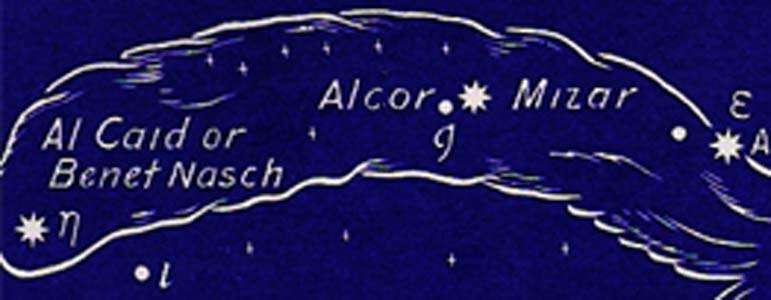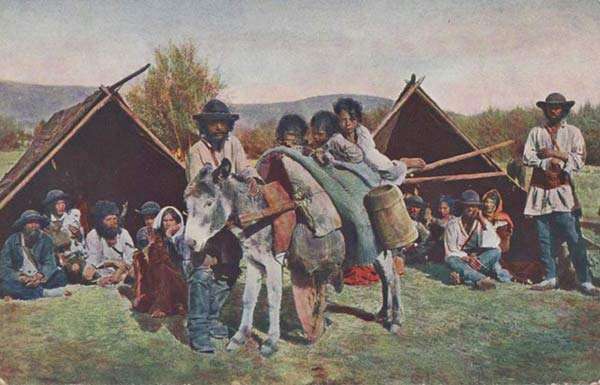|
What Tamas also had learned from him, and what
he passed on to us, was looking at the stars, especially the Polaris
star and the Great Bear. It consists of four stars with a tail behind
it. We had to look at the uppermost star, where the tail goes and
down again [this is the star Mizar]. He said: “What do you see?”
I
said: “A star”.
Look a little better, do you see something else?”
“Yes,” I said, “There is another little light point next to it.” Next to
this star in the tail of the Great bear is another small star. You have
to look very careful in order to see it. There were three or four boys
and two girls, and only three of them could see the little star. The
others didn't see anything. Tamas said that those who could see it have
a good intuition, a good observation, a rationality that is coupled with
a feeling for the metaphysical. This connection was very important to
him.
When somebody can see this star, then this indicates another
thought structure. You can't always see it, it suddenly pops up. I still
look at it, and sometimes I think it is my own projection. Much later I
came to know that this little star of the fifth magnitude is behind
and above the second star in the tail of the Great Bear, and it is
called Alcor, which means test. [This comes from the 14th century
Arabian name of Al Sadak.] In other civilizations it was also a custom
to use this star to test for paranormal abilities in initiation rituals.
In Hungarian, and especially in shamanistic tradition, the Great Bear is
very important. We give the Great Bear three names, as with many
other constellations: a profane, a sacral and a divine name. The profane
name is The Wagon, the sacral name is The Great Bear, and the third,
magical and mystical name is the Gönzöl.
The Hungarian etymologists
have not been able to find where that word comes from. Literally, it
means a person between the gods and humans, who brought us civilization.
It is told that the Gönzöl was sent from heaven to teach people
practical things on the technical, psychological and psychical level.
When people had learned all this, the Gönzöl went back to heaven in his
fiery chariot in the direction of the Great Bear.
There is another
version of this story in which he wanted to go back after he had
accomplished everything, but people grabbed him and ate him to keep his
knowledge here on earth. That was the holy or magical cannibalism. Thus,
his chariot left without him, and it went to heaven where it is still
floating around.
In Hungary there is also a village that is called
Gönzöl. It is on an island in the Donau, between Estergom and Komarom,
close to the border between Hungary and Czechoslovakia. There are
written documents about this place since the twelfth century, but the
village is much older. In that village was a family called Gönzöl, and
the oldest of most apt member of the family was always the judge in that
area. From far away people came to him to ask or hear his judgment,
because he was a very just man because he had his knowledge from heaven.
In Hungarian there is another meaning of the word Gönz, when it is
said: “he was the Gönz,” that means, he is dressed poorly. That is a
reference to the Gönzöl who was shaman and walked around in ragged
cloths. Gönzöl means mediator, a shaman who sent by heaven to help
mankind. Therefore it was important that Tamas let us always look at the
Gönzöl, the Great Bear.
I have another idea about that. In our times
we speak of flying saucers, and where they might be from. With many
people's cosmology we find that they considered certain constellations
holy, because people went to them, or beings came from them. Maybe they
should point their radio-telescopes in those directions to see if they
have civilizations. I think that they were not gods, because god is only
pure spirit. Maybe they were higher civilizations who came here and
stayed and left behind a memory of the visit of the gods or ambassadors
of the gods.
In Hungarian mythology, the Gönzöl is not a god either.
He is an ambassador, although with the northern people of Siberia, he is
called the son of god, or god's faithful servant.
I think that the
observation of the Gönzöl or the Polaris star is based on realistic
facts, but then too on the psychological or psychic level. Tamas also
said that one does not have to look at the star itself to remain in
contact with it, but you can put your thought with it when you are
falling asleep. Even in the daytime. At that time we didn't know that
the starry heaven was also present during the day time. But we had to
try to remain contact even during the daytime.
That is a parallel
way of thinking. You do not have to have the object in front of you in
order to experience it. That is not necessary as we can have direct
contact by synchronicity. Tamas Bacsi always said: “Why is it that you
can get contact with your ancestors in the Milky Way? That is so far
away. Look at your finger, and look at the tree over there, and look to
the stars. What did you notice?”
“Nothing,” I said, “A finger, a
tree, stars.”
“What you didn't notice is that looking at these
different things takes the same time. There is no difference.” That is
the simultaneity. That made a big impression on us, But it didn't make
us think about it. Now I think that there is way of thinking that can
comprehend the immediacy of everything, independent of space and time..
That is the state Tamas Bacsi called “Traveling without moving.”.
We
often went with Tamas Bacsi to the lake, especially when the wind was
quiet, and the surface of the water like a mirror. We were just sitting
there and we didn't speak. He was looking at the water for hours,
fascinated. When we asked him what he was seeing, he answered that he
was looking at his master. He was in the presence of his master. He saw
him in the reflection of the water. When we asked him what else he was
seeing, he said: “Everything you want.” he said: “When your master
appears, when you see the face of your master, then you can see anything
you think about.”
Then we asked: “How deep can you see that?”
"Yes,”
he said, “Even beneath the water, even the bottom you can see, and still
deeper, all the way into the underworld, into hell.”
There were boys
from the vineyard hills, and I myself had an aunt who lived over there.
He told these boys: “You don't have to come down from the hills to the
lake to see all that. Up on the hill is a deep water well.” That was a
really deep well, about 60 to 80 meters deep, from which the water had
to be hauled.
He said: “You can look at the reflection of the water
in that well,” Of course, it depended on the light, what you were
seeing. On a bright day you could see a light circle of about 50 to 60
cm in diameter, while the well itself was two and a half meters wide.
Sometimes you saw a light circle of only 10 cm in diameter. It depended
on the lighting and the angle of looking.
“Look at the reflecting
point in the water,” Tamas said, “and think of somebody. When that
person appears, you can ask him a question, or see what happens.” As
children we looked at it as a fun game. We were standing around the
well, and looked in it. Of course, all kinds of images came up. Actually
it is a kind of psychological test. When you are looking in a bright
circle of light, very deep inside a well, then something happens inside
your head. You have the feeling of dizziness. That is why it is said
that the deep pulls you down. When you are not afraid of the dizzies,
and you keep mastery over yourself, then you can feel that inside your
brain something is happening. It feels that your brain is turning like a
spiral, very, very slowly, or very rapidly. Sometimes it reverses. Tamas
probably learned this from his master too. Aside from the stick, this
was very important, looking at the flat surface of the water. When Tamas
looked at it, he was not only in contact with his master, but he was
working himself. He never told me what he wanted to achieve, he only
said: “Do you see the Milky Way out there?”, “The spirits of the
ancestors are there, and one has to live his life in a pure and
beautiful way in order to go there.” In Hungarian mythology, the fallen
heroes and good people are not going to Valhalla, but to the Milky Way.
It does not mean that it is a paradise, but life continues like on
Earth, but more refined, sublimated. There are no passions, no money, no
sickness, nothing of that nature. One is in spherical harmony. This was
his thinking.
When I think about it, he was using the communication
with his master to purify himself. It was a spiritual exercise to change
one's inner being. Not only to gain knowledge or to experience
something, but to work on his spirit, and to make it a better
instrument.
|



